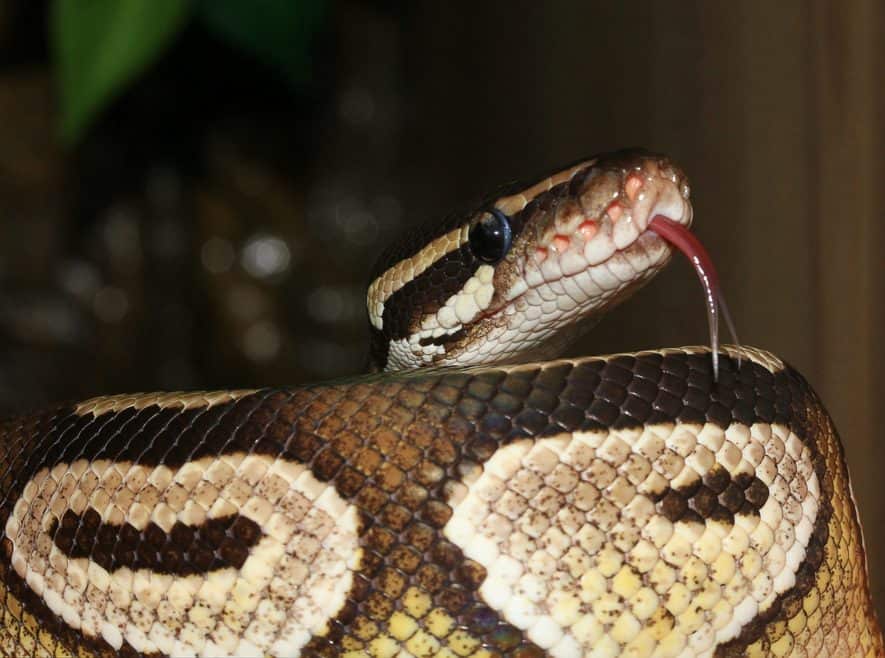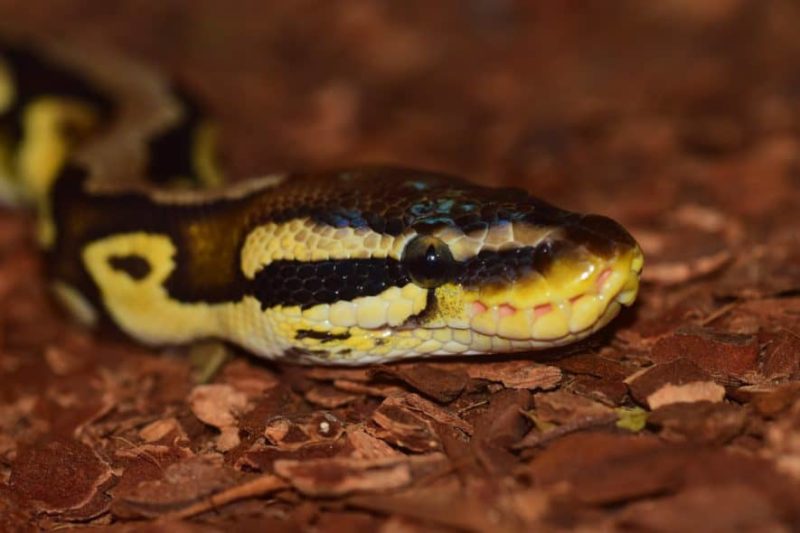Have you ever wondered what it takes to create the perfect home for a ball python? These fascinating snakes have sweet personalities and beautiful color patterns. But, just like any pet, they deserve a comfortable and suitable habitat or enclosure to call their own home.
Keep reading to learn what’s required in preparing a ball python enclosure. But before that, we will examine the ball python’s natural habitat, which will inform some of our choices and decisions moving forward.
Quick List of Essential Ball Python Habitat Requirements
- Tank Size: (Minimum of 48″ x 24″ x 24″ for an adult (larger is better)
- Tank Type: Glass aquarium, PVC/plastic enclosure
- Substrate: DIY tropical mix (topsoil, ReptiSoil, play sand), cypress mulch, orchid bark, newspaper, or paper towels
- Heating: Basking spot of 95 degrees Fahrenheit; cool side should be 75-80 degrees Fahrenheit. Radiant heat panels and heat lamps provide heat.
- Thermostat: Essential to control heating elements safely.
- Lighting: Optional, but a full-spectrum fluorescent can enhance appearance. A 12-hour light/dark cycle on a timer is beneficial.
- Humidity: 50-60% generally. Increase to 70-80% temporarily during the shed. Misting and a humid hide box help.
- Hides: At least 2, ideally 3 or 4, placed at both warm and cool ends of the enclosure.
- Water Dish: Large enough for soaking is optional but recommended.
- Thermometer/Hygrometer: Digital versions for accuracy.
🐍 Further Reading: The Complete Ball Python Care Sheet
Ball Python Natural Habitat
The ball python habitat is native to range within West African coast and central Africa stretching roughly from Senegal to Sudan and Uganda. Most imported ball pythons hail from the countries of Ghana, Benin or Togo.
They primarily inhabit grasslands, scrublands, savannas and open forests. Ball pythons may also live in disturbed areas, around human habitations or farms. They do not typically inhabit rainforests (or other dense forests), nor do they live in deserts or extremely arid places. Ball pythons spend most of their time in rodent burrows, which provide them with shelter and moderate temperatures.
Ball Python Cage: What Type of Tank Is Best and What Size Should It Be?
The first thing you’ll need to provide your ball python with is a suitable enclosure. There are several different types of enclosure from which you can choose, and each presents different benefits and drawbacks.
The most commonly used enclosure types include:
Glass aquaria
Glass aquaria are readily available and typically quite affordable. They also offer unparalleled visibility, which will make it easy to see your pet. However, aquaria are quite fragile, and they can be difficult to move around. Additionally, glass aquariums do not retain heat very well.
For effective heat management in a glass enclosure, consider covering three sides with opaque material like construction paper to create a sense of security and make creating a temperature gradient easier.
Commercially manufactured cages
Commercially manufactured reptile cages are usually the best option for ball python keepers. Commercial cages are typically made from lightweight plastic like PVC or HDPE.. They feature front-opening doors are designed to accommodate heating devices, and hold humidity well… These cages come with a mesh top to offer better ventilation and secure lamp fixture placement.
It’s important to choose a front-opening enclosure, as this makes accessing your snake easier and less stressful for them. They are also more secure and reduce escape risks.
Plastic storage boxes
Plastic storage boxes can make suitable ball python habitats, and they are both affordable and lightweight. They’re also easy to find at big-box retailers and hardware stores. However, they don’t provide a good view of your pet, as they’re typically translucent (as opposed to transparent). You’ll also need to modify them by drilling air holes and making them escape-proof.
Custom-built enclosures
Custom-built enclosures are a great option for keepers who have the skill and desire to build them. However, they are usually best designed by keepers with a bit of experience, rather than beginners. Materials like sealed wood, PVC, and glass are popular choices.
Important Note: If using a glass enclosure with a screen top, always use lid locks. Ball pythons are escape artists! Avoid using tape to secure lids, as it poses a significant injury risk to your snake
Enclosure Size and Dimensions
No matter what type of enclosure you select, you must ensure that the length of the enclosure should be at least equal to the length of your snake. This gives your python the room it needs to stretch out fully.
Habitat size is a hotly debated topic among keepers, but generally speaking, an adult ball python approx. 3 feet will typically need an enclosure measuring at least 48″ x 24″ x 24″. Also, 8 square feet of floor space offering at least 2 feet of vertical space allows for beneficial climbing opportunities, with more height being even better – this is especially important for males.
A hatchling of 300g would thrive in a 10-gallon sized enclosure or a tub with approximate measurements of 20″ x 11″ x 13″. Juveniles under 3 feet in length typically do well in enclosures measuring 36″ x 18″ x 18″ or larger. They can even be housed in their long-term adult enclosure provided there is plentiful cover and ample hiding spots.
🐍 Further reading: Can Ball Pythons Live Together?

Ball Python Enclosure: Providing the Proper Lighting and Temperatures
Now that you’ve selected an enclosure for your ball python, you must provide proper temperatures and lighting for the habitat. Generally speaking, it is quite easy to provide lighting for a ball python, but you may need to make repeated adjustments to establish the correct temperature range for your pet.
Ball Python Habitat Lighting
Ball pythons – like most other snakes – will remain healthy and happy without any specialized lighting. The ambient light entering their enclosure will provide all the light they need. In fact, ball pythons are primarily nocturnal, so extremely bright lighting will often cause them to hide.
However, you can help your snake look his best by incorporating a full-spectrum fluorescent fixture over the habitat. You needn’t use a light that provides UV radiation; simply choose a light that provides a well-balanced color spectrum and a moderate light intensity.
Be sure to plug the lights into a timer so you don’t have to worry about turning the lights on and off every day. This will also provide the snake with a consistent light-dark cycle, which is important for your pet’s health. A 12-hour cycle (12 hours of light, followed by 12 hours of darkness) works well, given the species’ equatorial distribution.
🐍 Further Reading: Ball Python Lighting Needs and Requirements
Ball Python Habitat Temperatures
Ball pythons prefer relatively high temperatures, like those in their natural range. However, you should always provide snakes (and other reptiles) with a thermal gradient. This will allow them to access a range of temperatures at any given point in time.
To create a thermal gradient, you’ll need to place all of the heating devices for the habitat at one end of the enclosure. This will create a basking spot, which provides the warmest temperatures in the habitat. Ideally, the temperatures at the basking spot should be about 95 degrees Fahrenheit during the day.
The opposite end of the habitat should provide somewhat cooler temperatures. Temperatures onin the cooler side should below- to mid-75-800s Fahrenheit isare ideal. Just be sure that they are below 80 degrees so that your snake can cool off if necessary. The temperatures between the basking spot and the cool side of the enclosure will decrease with increasing distance from the heat source.
You can use heat lamps, heat tape, heat pads or radiant heat panels to supply the heat for your pet.
Personally, I’ve always preferred overhead heat sources, such as lamps and radiant heat panels. Overhead sources reduce the likelihood that your snake will suffer burns, and they’re probably better from a fire-safety perspective.
However, other keepers prefer the convenience heat pads or heat tape provide. Just be sure to monitor the temperatures provided by these types of heat sources. It’s also important to follow all of the manufacturer’s instructions during installation.
Unless the temperatures in the habitat fall below about 68 to 70 degrees Fahrenheit at night, you can simply turn off the heat sources overnight. If you need to provide supplemental heat at night, do so with heat sources that do not produce light.
🐍 Further Reading: Ball Python Temperature & Humidity Needs and Requirements
Suitable Humidity for a Ball Python Habitat
Snakes need suitable humidity levels to remain healthy. If kept too dry, they’ll have difficulty shedding properly, and they may become dehydrated. On the other hand, snakes kept in excessively humid environments may develop potentially fatal skin diseases. Improper humidity in either direction may also cause the development of respiratory infections.
Ball pythons typically prefer a relative humidity of 50% to 60%. That’s a bit damper than the air in most homes, so you’ll likely find it necessary to mist your pet’s habitat lightly with room-temperature water each day. You can also add water to the substrate or increase the size of the water dish to raise the humidity.
It’s also a good practice to provide your ball python with a moist hide box (in addition to his normal hide box discussed below). This will help prevent dehydration and give him a good place to sleep when he is entering a shed cycle. This will help promote full, problem-free sheds.
You can make a humid hide box by adding a bit of damp (not wet) moss or mulch to a small container. Just cut a small door in the side of the container to provide your snake with access to the retreat.
During the shedding cycle, aim to temporarily increase the humidity in your snake’s enclosure to around 70-80%. This aids in a complete and healthy shed.
If your ball python’s habitat is too damp, you’ll need to try to reduce the humidity and dry the cage out a bit. The best way to accomplish this is by increasing the amount of ventilation provided. You can also try decreasing the size of the water dish. Invest in a hygrometer to measure humidity levels accurately and place it in the middle of your ball python’s enclosure.
🐍 Further Reading: The Ball Python Behavior & Health
Bedding: What Is the Best Substrate for a Ball Python Enclosure?
There are a variety of different substrates you can use to maintain a ball python. No single substrate is ideal for all situations, so you’ll need to compare the options available and select the best choice for you and your pet.
Some of the most common ball python substrates that can be used include:
DIY Tropical Mix
A combination of organic topsoil (40%), Zoo Med ReptiSoil (40%), and play sand (20%). This mix offers excellent affordability and humidity retention. Layering with sphagnum moss and leaf litter enhances its effectiveness.
Cypress Mulch
Cypress mulch is another great choice, and it is the author’s favorite substrate for ball python maintenance. This mulch is very affordable (although the price varies by geographic region), permits burrowing and retains moisture well, which can make it easier to maintain the proper enclosure humidity. Cypress mulch also smells nice.
Orchid Bark
Orchid bark is somewhat similar to cypress mulch in that it is helpful for maintaining a high humidity level. It also looks great and allows snakes to burrow. However, orchid bark is often relatively expensive, so it isn’t commonly used in large enclosures.
Newspaper
Newspaper is probably the simplest, most hygienic and most affordable substrate you can use. It is easy to replace when soiled, and your snake can even crawl under the newspaper to hide if he wishes. Generally speaking, newspaper is the best choice for novice snake keepers.
Paper Towels
Paper towels provide most of the same benefits that newspaper does, and it is also a good choice for beginners. It can be difficult to use paper towels in adult-sized enclosures, but it works very well in the relatively small habitats used for hatchling and juvenile snakes.
Just be sure to weigh the pros and cons of these substrates before making your choice. However, you can always decide to make a change later, if you determine that your first choice isn’t working well.
Bad Substrates (Avoid These)
- Reptile Carpet: Difficult to clean properly and doesn’t handle messes well.
- Aspen Shavings/Chips: Prone to rapid molding in humid environments.
- Pine/Cedar Shavings: Potentially harmful due to oils that may cause neurological issues in reptiles.
🐍 Further reading: Best Ball Python Substrates and Beddings
Additional Accessories and Supplies for Your Ball Python Cage
In addition to heating and lighting devices and an appropriate substrate, you’ll need a few more things to turn your ball python’s enclosure into a suitable habitat.
- All ball python enclosures must include at least one hide box, and it is preferable to include several. Failing to provide your snake with a good place to hide will cause him a great deal of stress. It is also likely to suppress his desire to feed. An inverted plastic tub with a door cut into the side is ideal, but there are also commercial options available.
- You’ll also need to add a water dish to the enclosure and keep it filled with clean water at all times. You can use a plastic water dish, but glass, ceramic or stainless-steel dishes are preferable. The dish needn’t be large enough to permit your snake to soak, but you can provide a dish large enough to accommodate your snake’s entire body if you like.
- You can add plastic or real plants to the enclosure if you like, but they aren’t necessary. Plastic plants are safer and won’t require any care, but some keepers prefer the look of live plants. Just be sure to avoid toxic species or those that are armed with thorns or spines.
- You must also obtain a high-quality digital thermometer to monitor the ambient temperatures in the habitat. In fact, it is also wise to purchase a non-contact infrared thermometer, so you can also monitor surface temperatures in the habitat.
> Further Reading: The Ball Python Diet
Now It’s Your Turn
As you can see, it isn’t terribly difficult to provide a ball python with a proper habitat. Just be sure to start with a suitably sized enclosure, heat the habitat appropriately and choose a good substrate. Add a few hiding boxes, a water dish, and a digital thermometer and you’ll have a habitat that’ll keep your ball python healthy and happy for years to come.
I’d also offer a bit of personal advice to new keepers:
Although many new keepers are eager to create a beautiful, intricately decorated habitat for their pet, it’s probably wise to start with a very simple enclosure. Don’t get me wrong – I love setting up complicated and elaborate vivaria for ball pythons (and other snakes), but I see a lot of new keepers make mistakes when doing so.
Instead, I recommend that first-time snake keepers maintain a simple and straightforward habitat for six months to a year before setting up a natural-looking vivarium. This will give you the chance to learn the basics of habitat design and maintenance, which will help you avoid a number of common problems.
We hope you’ve found this guide helpful and would love for you to share it with your snake-keeping friends if you enjoyed it.











55 Comments
Hello, I just adopted a 9 year old Ball Python who needed to be re-homed. He came with his enclosure and everything he was used to. I have had several snakes previous to this guy. I’m letting him adjust to the new surroundings. His previous owner said he was held quite a bit. I’m giving him his space right now. I do reach in and touch him, but I can tell he is not ready to be held. I thought I had a question, but now realize I answered it myself. Thank you for all your help.
Jacqueline
Hi Jacqueline,
It sounds like you’ve got everything under control! Sometimes, all we need is to talk (or type) things out to find our answers. 🐍 It seems your new scaly friend has landed in caring hands. Remember, even the wisest of snakes sometimes need a little “me-time” to adjust to their new surroundings. Give him a gentle boop on the snoot from us when he’s ready. Thanks for the chuckle, and best of luck with your ball python adventures!
Hello,
I am in the process of getting my first snake. I have been hearing a lot of conflicting information which your article has helped with. But I still have a few unanswered questions:
1) I’ve been told that vertical tanks are better for male BP, versus using a horizontal tank for females. Because males have a higher inclination to climb. Is this true? Does it matter either way?
2) In using a thermometer or humidity gauge, should it be located higher or lower in the enclosure? Especially in the use of a vertical or horizontal tank?
3) What is the proper response to a bite? Like the snake gets frightened and latches onto you. How do you get it to release? How do you treat a wound? What should you do for your snake afterwards?
4) I have been told that brushing the snake lightly with a wet toothbrush can help with shedding. Is this true?
5) Is there any advice or tips for a beginner that has not yet been stated?
Hi Marie!
I’m glad to help clarify some of your questions:
Tank Orientation: While ball pythons (BP) can climb, they are primarily terrestrial. Both males and females can benefit from some vertical space, but it’s not a strict requirement based on gender. What’s more important is ensuring the enclosure has the appropriate square footage, hides, and climbing opportunities if you choose to provide them.
Thermometer/Humidity Gauge Placement: For a horizontal tank, place the thermometer and humidity gauge on the warm side near the substrate level, as this is where your snake will spend most of its time. If you have a vertical tank, it’s a good idea to have multiple gauges at different heights to monitor the gradient.
Response to a Bite: If bitten, remain calm. Do not pull the snake off as this can cause more damage. Instead, pour a little bit of mouthwash or rubbing alcohol on the snake’s mouth (not into its nostrils). The snake will usually release immediately. Once the snake is safely back in its enclosure, clean the wound with soap and water, apply an antiseptic, and monitor for signs of infection. After a bite, give your snake some time to calm down and try to understand what triggered the bite to prevent future incidents.
Wet Toothbrush for Shedding: Yes, lightly brushing a snake with a damp toothbrush can help with shedding, especially for those stubborn patches. Always be gentle and ensure the brush is soft.
Additional Tips: Always research and understand the specific needs of the species you’re getting. Ensure you have the setup ready before bringing the snake home. Regularly monitor the snake’s health, behavior, and enclosure conditions. And most importantly, be patient. Snakes can take time to adjust to new environments, and it’s essential to give them the space they need.
I hope this helps, and best of luck with your new snake!